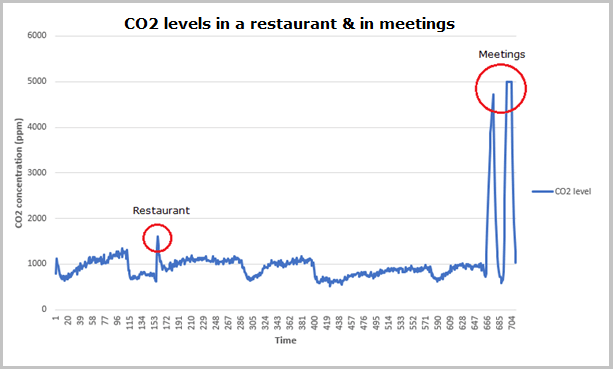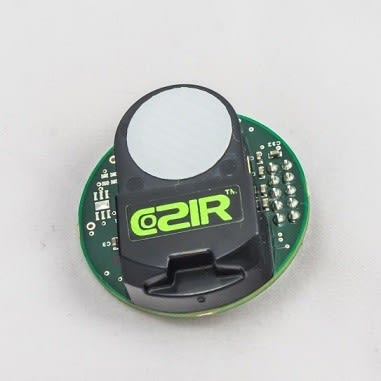Travels with a CO2 sensor
Follow articleHow do you feel about this article? Help us to provide better content for you.
Thank you! Your feedback has been received.
There was a problem submitting your feedback, please try again later.
What do you think of this article?
It’s well known that humans breath out Carbon Dioxide (CO2). On average, the amount of CO2 exhaled is between 35,000-50,000 ppm (parts per million). So what happens to CO2 levels when a lot of people get together in one place? Or when a few people are in an enclosed space? Would this have a noticeable impact on CO2 levels? We took our CozIR®-A CO2 sensor on a recent trip to Asia to find out!
The first experiment took place on a train journey. At around lunchtime on the journey, a large party of school children and teachers boarded the train. The graph clearly shows that it only took around 20 minutes for CO2 levels to soar from around 700 ppm to over 4000 ppm.
Later on our travels, we took the CozIR®-A sensor to a restaurant where we had a private dining room for 15 guests. The graph shows how levels rose sharply from around 700 ppm to almost 1600 ppm in under 30 minutes. Levels rose even more significantly in a series of meetings later that week. In a high-rise office room, CO2 levels rose from around 700 ppm to over 4700 ppm in only 45 minutes. And with 4 people present during the next meeting, it only took 30 minutes for levels to rise from 650 ppm to peak at 5001 ppm.
The results of travelling with our sensor show just how significantly CO2 levels can rise from ambient levels, which are around 400 ppm. Not only that, the data also shows the speed at which levels can increase if not diluted with fresh air. Some of the measurements recorded on our travels reached well above 2000 ppm. This is the concentration level associated with symptoms such as of loss of concentration, headaches and sleepiness.
As well as measuring CO2, the CozIR®-A sensor can also record temperature and relative humidity (RH) if required. Typical NDIR CO2 sensors generally demand a lot of power, and so need be connected to a mains power supply. Because GSS sensors use LEDs as the source of infrared, they can run on very little power. This means they can be integrated into battery-powered monitoring systems, including ‘fit and forget’ solutions. With its small form factor, the sensor allows easy integration into compact devices. For example, the sensors could be built into a wirelessly connected ventilation device, achieving a battery life of over 15 years.
This proprietary LED technology also means a rugged solid-state design. This enables precise measurements in high vibration or unstable conditions. The fast startup time of the LED also caters for high-speed sensing in applications where a fast measurement is needed. Examples of applications using GSS sensors include breath monitors for patients with respiratory conditions; DCV units; portable leak detection instruments; handheld MAP analysers; and even wearable CO2 monitors for astronauts on the International Space Station!
Sensor evaluation kits are available, to allow for proof-of-concept (PoC) testing and evaluation in different applications.
[i] http://www.energy.wsu.edu/Documents/CO2inbuildings.pdf
[ii] https://www.climate.gov/news-features/understanding-climate/climate-change-atmospheric-carbon-dioxide
[iii] https://ohsonline.com/Home.aspx
Note: These products will be available from RS soon.






